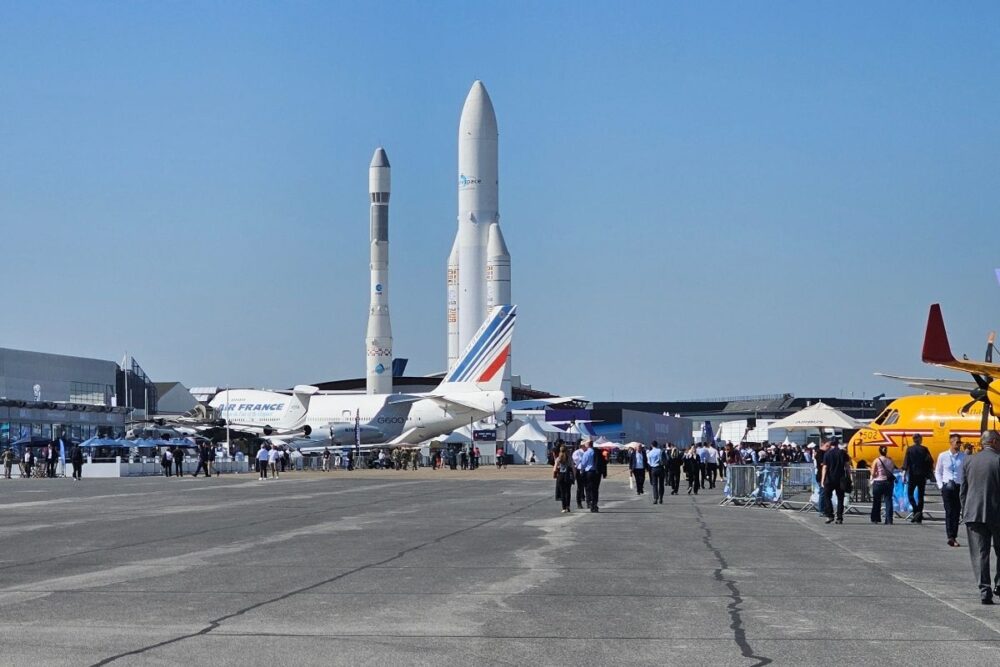The 2025 Paris Air Show was always going to be unusual, with the spectre of conflict in many regions, a major air disaster of unknown cause the week before the show, and full order books at Airbus and Boeing. Indeed, it was, with a very quiet first day followed by busier but still muted remainder of the week. John Walton reports from Chalet Row.
Geopolitical Issues, Tariffs, Trade Wars and Actual Wars
It’s hard to think back to a year where a Paris Air Show — or its Farnborough equivalent in even years — was so overshadowed by geopolitics, tariff threats, and conflict.
The impacts here are enormous. Overflight is just one, requiring multiple airlines to completely rethink huge swathes of their route networks and corporate strategies. Supply chains are another. One interiors manufacturer we sat down with at the show highlighted a single product line with elements produced in the EU, the UK, the US, and Mexico.
The key question where the industry needs clarity — and for which no-one, seemingly including the US government, has answers — is whether aviation can hope to retain the tariff exemptions on which so much of its already creaking supply chain depends.
Already, US airlines are taking their Airbus widebody airliner deliveries overseas to avoid tariffs. Delta is flying new aircraft from Toulouse to Japan and is using them on exclusively international routes so that tariffs are not imposed on them as US domestic market jets. But this is not a longterm solution, nor is it one suitable for all aircraft types used within the US.
Fundamentally, the commercial airliner supply chain, from airframes to engines to interiors and beyond, is set up based on the assumption of zero-to-minimal tariffs. The world’s largest commercial aircraft engine manufacturer, CFM, is a joint venture between the US’ GE and France’s Safran. Its LEAP engines power the Boeing 737 MAX, Airbus A320neo — and Comac C919. Or at least they did until, a couple of weeks before Le Bourget, the US suspended engine sales to China’s Comac. But what about Chinese operators of Boeing and Airbus aircraft? Or Airbus’ A320neo family production in Tianjin?
To compound matters, at the show, France’s Safran and US manufacturer Crane were announced as supplying Comac’s widebody, the C929. Will these agreements ever come to pass, though?
Global Markets and Orders Were Muted
Among the many reasons why Le Bourget 2025 was so unusual was the entirely one-sided order book in the big competition between Boeing and Airbus.
Following the Air India flight 171 crash at Ahmedabad, Boeing cancelled its announcement plans. The US airframer marked zero orders at the show. The only media event was a closed-door, photos-only signing session for Japanese photographers, confirming an All Nippon Airways order from earlier in the year.
Airbus, meanwhile, had a solid but mostly unremarkable series of orders. And this fairly muted performance was largely driven by the fact that the only Airbus jets with significant availability before the end of the decade are the A220 small airliner and the A330neo re-engined widebody.
The A220 made some of the biggest headlines at the show. Airbus announced a densification effort that will increase the aircraft’s maximum capacity from 149 to 160 seats by adding a second overwing exit. In parallel, LOT Polish Airlines placed a major order for 40 A220s, evenly split between the smaller A220-100 and the larger A220-300 models.
The LOT order was largely reported as a win for Airbus and the A220 and Embraer over the E-Jet E2 (LOT being an existing E-Jet E1 and E2 airline), but at its upper capacity the A220 also competes with the Boeing 737, of which LOT is also an operator.
Returning to the theme of geopolitics, a much-rumoured China order for Airbus did not materialize. It was perhaps because of a forthcoming state visit to the country by European leaders to mark the 50th anniversary of diplomatic relations between China and what is now the EU.
Decarbonization Has Seemingly Hit a Roadblock
This was the year where the bubble of lofty (one might even say airy) goals around sustainable aviation fuels (SAF) and alternative fuels like hydrogen were popped by reality.
The fundamental technological building blocks are there, for certain, but this was not a Le Bourget where, as in the past, airframers were touting their partnerships on carbon capture or initiatives in cooperation with airlines.
Commercial aviation will take as much SAF to drop into its tanks as it can get, but much of the focus in recent years has been sending clear SAF demand signals to industry and governments in order to encourage research into feedstocks and production.
Perhaps spurred by the change of direction in the White House, the industry is being much more realistic about what it can — and, more accurately, what it cannot — promise on its own.






![Image [Buying Guide] How to Choose the Right Protection Gloves?](/wp-content/uploads/sites/3/Gloves-1-320x213.jpg)



